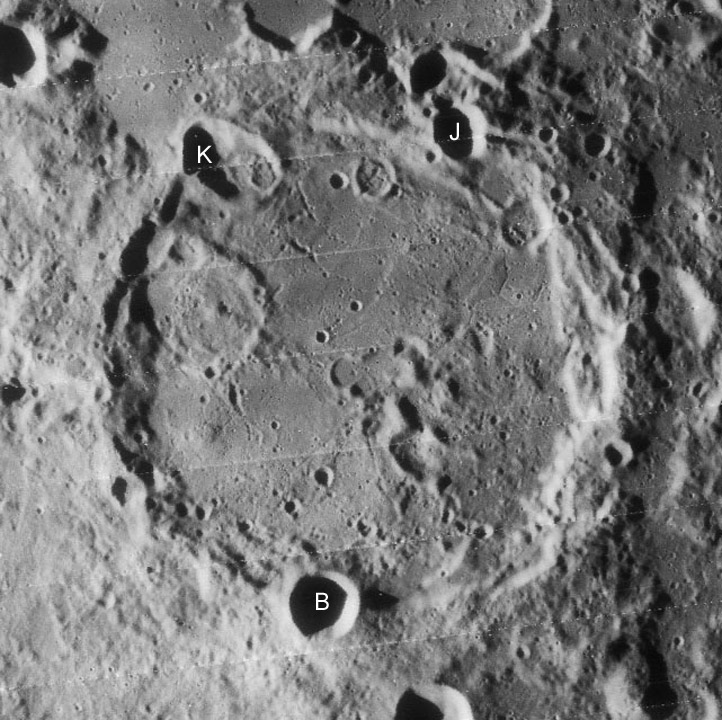LPOD June 24, 2008
UNKNOWN VOLCANIC CENTER

Lunar Orbiter IV-191H image from USGS Lunar Orbiter Digitization Project, processed by Jim Mosher
Using the recently re-digitized ancient Lunar Orbiter IV photograph, Jim Mosher has produced the best image in existence of Messala, a 125 km wide crater north of Geminus. Messala is considered by the US Geologic Survey to be older than the Nectaris Basin, and as is typical of older craters, its walls and floor record many different events. The most interesting feature is the evidence for fluids on its floor. I could have said volcanism but was hesitant because the narrow rilles below the crater Messala J remind me of similar cracks on impact melt within the Orientale Basin. But since there is no plausible source of impact melt here it is likely the material really is volcanic. This is made more likely by the nearby lacii Speii and Temporis, except those are dark mare lavas and the materials in Messala are brighter. The northern part of the floor is relatively smooth with small crater chains and a hint of a mare ridge. These chains could be collapse pits or secondaries - the high-Sun Clementine image resolves the issue, by revealing pyroclastics around the chains - they are volcanic vents. The crater between J and K has a floor cut by thick troughs and seems to be a floor-fractured crater - one of the smallest on record. There is a rough pancake feature on the elongated floor of K - a wall slump or a viscous dome? On the southwest edge of the floor there is a knob that I had previously speculated might be a dome. It still might be, with a broader shallower section extending south. Another possible, but uncertain, dome is NNE of the crater B. This putative dome is about the same size as the other one and is cut by a rille/crater chain. This crater has many manifestations of volcanism, few recognized until this good image became available.
Chuck Wood
Technical Details
May 25, 1967; 09:47:05.51 UT -- from an altitude of 5503 km; remapped to a north-up aerial view centered on Messala
Related Links
Rükl plate 16
COMMENTS
To post comments regarding this LPOD you need to first register for the wiki by clicking the "Join this space" link under the Full Moon icon in the upper left corner of the screen, and wait for your membership to be approved. Once registered, you may still need to "Sign In" (link at top right of screen) to remove the "Protected" icon from the top of the LPOD page. Once you don't see a "Protected" icon, please click here and enter your comment in the space below. Please do not edit the LPOD itself!
1. Chuck - I was just uploading this to replace a rather grainy older version of the same scene on the Wiki, so it's gratifying to find it holds so much of interest to the eye of a geologist. The amount of processing and re-mapping was really quite small. To be honest, since the same frame was used for producing the USGS global mosaic you should be able to recreate essentially the same image with Map-a-Planet, although the results from that site seem a bit erratic as to image quality -- sometimes fine, othertimes strangely blocky. Direct access to the USGS server with the MapMaker Link Generator seems to give smoother results, more like LTVT. This image was taken from a rather great distance for a Lunar Orbiter photo, but it can still be profitably blown up another factor of four or so (the original detects craters to about 0.4 km diameter). Those who would like to use LTVT to do this can find calibration data on the LTVT Wiki site; as well as the whole frame (about a 7 MB download), of which the part shown here is a small fragment. You should also be able to zoom in with Map-a-Planet. - Jim Mosher
2. Are my eyes playing tricks, or is there a faint pattern of squares in the upper third of the crater surface between K and J, showing straight lines and right angles. (??)
--Bill
P.S. Chuck--Apologies for being off-topic, but do you know how fast Saturn rotates at its equator in MPH? Someone asked me this at a recent public star party. We were looking at Saturn through my scope at high magnification. I explained that it was quickly drifting out of the field of view because the Earth was rotating at about 1,000 MPH at the equator, etc. The lady said that was interesting and then asked how fast Saturn rotates. I was stumped. I know it rotates once about every 10 hours, but I have no idea about its rotational speed. I tried, but I couldn't find an answer on the Internet. (??)